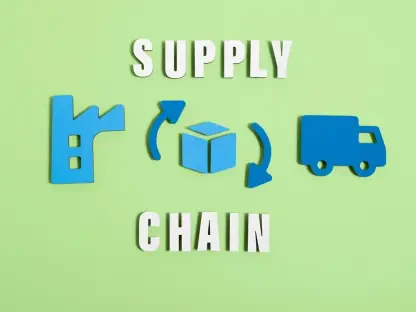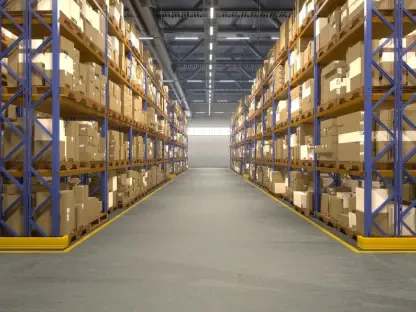The logistics sector is on the cusp of a technological revolution, spearheaded by the rise of Autonomous Mobile Robots (AMRs). As e-commerce and global supply chain demands continue to grow, the need for operational efficiency and automation becomes paramount. This article explores how AMRs are set to transform logistics and warehousing industries over the next decade, evaluating key drivers, technological advancements, industry applications, and future prospects.**Autonomous Mobile Robots: An Introduction**The integration of Autonomous Mobile Robots (AMRs) into the logistics sector marks a significant shift from traditional manual labor to automation. Historically, logistical operations relied on a vast workforce for tasks such as material handling and order fulfillment. However, the inefficiencies and costs associated with manual labor have paved the way for automation, with AMRs leading the charge in streamlining and optimizing these processes.
The Demand for Automation in Logistics
E-commerce Boom and Global Supply Chains
The exponential growth of e-commerce has dramatically intensified the need for efficient logistics solutions. Online retailers face unique challenges, such as labor shortages and complex fulfillment processes, which AMRs address by automating repetitive tasks and optimizing order processing. Consequently, as global e-commerce sales are projected to soar from USD 2.4 trillion in 2017 to around USD 3.0 trillion in 2018, the adoption of AMRs is becoming increasingly crucial for managing these escalating volumes. The ability to handle rising order quantities without compromising on speed or accuracy is vital for maintaining customer satisfaction and competitive edge.These robots help mitigate labor shortages by efficiently completing tasks that would traditionally require significant manpower. With AMRs, warehouses can achieve faster turnaround times, reducing delays and errors in fulfilling orders. This automation not only supports higher volumes but also contributes to better resource allocation, as human workers can be reassigned to more complex and value-added tasks. Therefore, the surge in e-commerce and global supply chain activities highlights the indispensable role of AMRs in modernizing logistics operations to meet contemporary demands effectively.
Operational Efficiency and Cost Reduction
The pressing demand for operational efficiency is driving the logistics sector towards automation. Traditional warehouse operations, often bogged down by inefficiencies and high labor costs, can substantially benefit from AMR deployment. By automating tasks such as inventory management and material handling, AMRs not only streamline operations but also significantly reduce labor costs, thereby enhancing overall productivity and profitability. Companies are increasingly adopting these robotic solutions to address challenges associated with manual labor, such as high turnover rates, recruitment difficulties, and the physical strain on workers.Furthermore, AMRs enable continuous, 24/7 operations without breaks, a capability that human workers cannot sustainably match. This relentless efficiency leads to higher throughput and faster response times, crucial in today’s fast-paced logistics environment. By handling monotonous and labor-intensive tasks, AMRs free up human employees for more strategic roles, enabling a more balanced and productive workforce. With the cost of robotics gradually decreasing and their capabilities expanding, the cost-benefit ratio of integrating AMRs becomes increasingly favorable for logistics operators striving for competitive advantage.
Technological Advancements Driving AMR Adoption
Artificial Intelligence and Machine Learning
The advancements in artificial intelligence (AI) and machine learning (ML) have revolutionized the capabilities of AMRs, making them more sophisticated and reliable. These technologies enable AMRs to navigate complex environments, adapt to dynamic conditions, and execute tasks with minimal human intervention. The continuous improvements in AI and ML are thus pivotal in enhancing the functionality and adoption of AMRs in logistics. AI algorithms enable robots to learn from their experiences, optimizing their performance over time and making them invaluable assets in a constantly changing warehouse environment.Additionally, machine learning models allow AMRs to anticipate and respond to potential obstacles or changes in their surroundings, ensuring seamless operations. These robots can integrate with warehouse management systems (WMS), providing real-time data and analytics to optimize inventory management and warehouse workflows. The predictive capabilities of AI-powered AMRs significantly improve decision-making processes, minimizing disruptions and boosting efficiency. As AI and ML technologies continue to evolve, their application in AMRs becomes more advanced, supporting the development of autonomous systems capable of handling increasingly sophisticated tasks within logistics operations.
Robotics and Sensor Technology
Cutting-edge developments in robotics and sensor technology are instrumental in driving the AMR market. Modern AMRs are equipped with advanced sensors and navigation systems that allow them to operate autonomously, efficiently performing tasks like picking, packing, and transporting goods. This technological progress ensures that AMRs can handle a variety of logistical tasks with precision and reliability, further solidifying their role in modern warehouses. The integration of Lidar, cameras, and ultrasonic sensors enhances the robots’ perception, enabling them to create detailed maps of their operating environments and navigate them seamlessly.These sensors help AMRs detect and avoid obstacles, ensuring safe operations in bustling warehouse settings. Furthermore, advancements in robotic hardware, such as improved grippers and manipulation mechanisms, allow these robots to handle a broader range of items, from fragile products to bulky goods, with minimal risk of damage. The combination of robust sensor technology and advanced robotics results in highly versatile AMRs that can autonomously complete complex tasks, such as sorting and packaging, accurately and efficiently. This level of sophistication not only reduces reliance on human intervention but also raises the overall standard of logistical operations.
Applications of AMRs in Various Industries
Retail and E-commerce
In the retail and e-commerce industries, AMRs are transforming warehouse operations by automating order picking, packing, and inventory management. These robots enable faster turnaround times and higher accuracy in order fulfillment, addressing the pressing demands of online retail. As a result, retailers can process large volumes of orders efficiently, meeting customer expectations for swift deliveries. The precise and consistent performance of AMRs in repetitive tasks translates to fewer errors and improved order accuracy, crucial for maintaining customer satisfaction in competitive markets.Additionally, AMRs offer scalability, allowing retailers to ramp up their operations during peak seasons or sales events without significant logistical challenges. The deployment of these robots ensures that retailers can maintain high service levels and meet delivery commitments even under increased demand. The automation of mundane tasks also optimizes inventory management, reducing stockouts and overstock situations by providing up-to-date inventory levels and enabling proactive restocking. This efficiency is pivotal in the highly dynamic retail environment, where quick responses to market trends and customer needs can significantly impact business success.
Healthcare and Pharmaceuticals
The healthcare and pharmaceutical sectors also benefit from AMR technology. In these industries, the accurate and timely management of inventory is critical. AMRs enhance operational efficiency by automating the transportation of medical supplies and ensuring precise inventory tracking. This automation not only streamlines processes but also minimizes the risk of human error, which is crucial in these sensitive fields. The precise handling capabilities of AMRs minimize the chances of damage or contamination, ensuring that medical supplies reach their destination in optimal condition.Moreover, AMRs contribute to maintaining strict compliance with regulatory standards by meticulously tracking and documenting the movement of supplies, thus facilitating traceability and accountability. The ability to operate in sterile environments without requiring human intervention further underscores the value of AMRs in these sectors. AMRs help hospitals and pharmaceutical facilities optimize their workflows, enhance patient safety, and maintain high levels of service even under pressure. This technological integration is transformative, significantly boosting efficiency and reliability in environments where precision and safety are paramount.
Transformative Impact of AMRs on Logistic Workflows
Autonomous Inventory Management
One of the most significant impacts of AMRs is on inventory management. Autonomous inventory robots continuously monitor and update stock levels, providing real-time data and insights. This automation eliminates the need for manual stock checks, greatly reducing the likelihood of stock discrepancies and ensuring that inventory is managed with unparalleled accuracy and efficiency. The real-time data provided by these robots enable warehouse managers to make informed decisions, optimizing inventory control and reducing the risk of overstocking or stockouts.Moreover, autonomous inventory robots facilitate predictive analytics, enabling better demand forecasting and inventory replenishment strategies. With accurate and timely insights, warehouse operators can proactively address potential issues, ensuring smooth and uninterrupted operations. This level of precision and efficiency in inventory management enhances overall supply chain performance, leading to improved customer satisfaction and reduced operational costs. The integration of such advanced automation demonstrates the transformative potential of AMRs in optimizing crucial aspects of warehouse management, positioning them as indispensable tools in modern logistics.
Enhanced Material Handling
AMRs are revolutionizing material handling within warehouses. Automated forklifts and mobile picking robots can transport goods and materials efficiently, reducing the need for manual labor and minimizing the risk of workplace injuries. The ability of AMRs to handle diverse material handling tasks ensures that warehouses operate more smoothly, with fewer interruptions and delays. The precision and consistency of robotic material handling lead to fewer errors and faster processing times, directly impacting productivity and operational efficiency.Additionally, these robots contribute to a safer work environment by taking over physically demanding and potentially hazardous tasks, thereby reducing the likelihood of accidents and injuries among human workers. The robustness and reliability of AMRs in material handling enhance the overall resilience of warehouse operations, making them more adaptable to fluctuating demands and unexpected challenges. This technological advancement underscores the pivotal role of AMRs in revolutionizing material handling practices within the logistics sector, driving improvements in both safety and efficiency.
Strategic Partnerships and Industry Collaborations
Notable Partnerships and Collaborations
Numerous partnerships and collaborations in the AMR market highlight the rapid evolution and innovation in this space. For instance, inVia Robotics’ collaboration with Tobi and Locus Robotics’ partnership with RightHand Robotics underscore the growing trend of cross-platform AMR solutions. These strategic alliances facilitate technological advancements and the development of more sophisticated and interoperable AMR systems. By combining their expertise, companies can create more versatile and efficient robotic solutions that address a wide range of logistical challenges.These collaborations also enable faster innovation cycles, allowing companies to stay ahead in the competitive AMR market. By leveraging the strengths and capabilities of different organizations, these partnerships drive the development of next-generation AMRs that offer enhanced functionalities and integration options. Such collaborative efforts are pivotal in accelerating the adoption of AMR technology across various industries, ensuring that logistics operations can benefit from the latest advancements in robotics and automation. This collective approach to innovation and development underscores the importance of industry-wide cooperation in advancing the capabilities of AMRs.
Leadership and Key Players
The rapid expansion of e-commerce has significantly increased the demand for efficient logistics solutions. Online retailers face unique challenges, including labor shortages and intricate fulfillment processes. Autonomous Mobile Robots (AMRs) provide a critical solution by automating repetitive tasks and streamlining order processing. With global e-commerce sales expected to rise from USD 2.4 trillion in 2017 to around USD 3.0 trillion in 2018, integrating AMRs is essential for managing these growing volumes. The capability to handle increasing order quantities without sacrificing speed or accuracy is crucial for maintaining customer satisfaction and staying competitive.These robots alleviate labor shortages by efficiently performing tasks that used to require extensive human labor. AMRs enable warehouses to achieve quicker turnaround times, minimizing delays and errors in order fulfillment. This automation not only supports higher volumes but also allows human workers to be reassigned to more complex, value-added tasks. Therefore, the surge in e-commerce and global supply chain activities underscores the essential role of AMRs in modernizing logistics operations to meet current demands efficiently.









